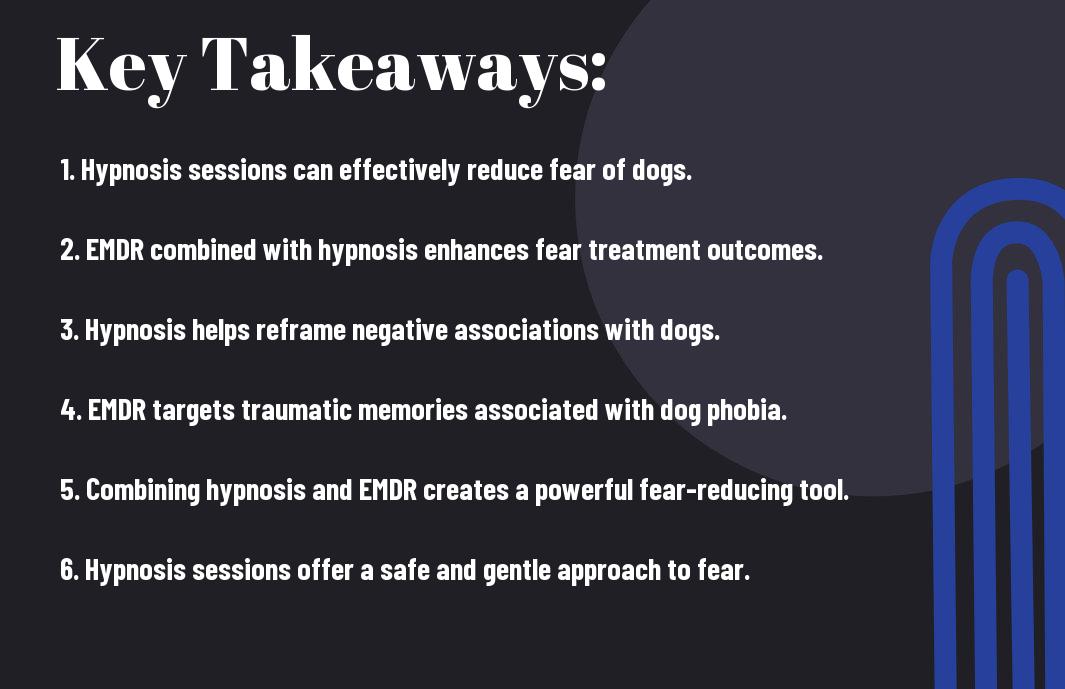Powerful Hypnosis Sessions and EMDR for the Fear of Dogs
With hypnosis sessions becoming increasingly popular for overcoming fears and phobias, combining this powerful technique with Eye Movement Desensitization and Reprocessing (EMDR) can provide advanced relief for those struggling with fear of dogs. This innovative approach can help individuals address the root cause of their fear, rewire their brain’s response, and ultimately experience a newfound sense of calm and confidence around their four-legged friends. Discover how this dynamic duo of therapies is transforming lives and creating lasting change in those battling canine phobias.

Key Takeaways:
- Hypnosis sessions: Hypnosis can help individuals with a fear of dogs by accessing the subconscious mind and addressing the root cause of their fear.
- EMDR therapy: Eye Movement Desensitization and Reprocessing (EMDR) can assist in processing traumatic experiences related to dogs, helping individuals overcome their fear.
- Combining hypnosis and EMDR: The combination of hypnosis sessions and EMDR therapy can be a powerful approach to effectively treat the fear of dogs.
- Addressing underlying issues: Hypnosis and EMDR can help individuals explore and address deep-seated fears or traumas that may be contributing to their fear of dogs.
- Long-lasting results: By working with a trained therapist using advanced hypnosis and EMDR techniques, individuals can experience significant and lasting improvement in their fear of dogs.

The Fear of Dogs: A Common Phobia
The fear of dogs, known as cynophobia, is a prevalent phobia that can significantly impact the daily lives of those who suffer from it. While some people may simply feel uncomfortable around dogs, others experience extreme anxiety and fear at the mere sight or thought of a dog. This fear can be debilitating and lead to avoidance behaviours that interfere with everyday activities and social interactions.
Prevalence and Impact
The fear of dogs is more common than one might think, affecting individuals of all ages and backgrounds. Research suggests that approximately 36% of people in the United States have a fear of dogs to some degree. This fear can be particularly challenging for dog owners or individuals who live in communities where dogs are prevalent, causing heightened levels of stress and anxiety.
Causes and Triggers
With various factors contributing to the development of cynophobia, including past traumatic experiences, genetics, and learned behaviours, understanding the root cause of this fear is crucial for effective treatment. For some individuals, a negative encounter with a dog in childhood can trigger a lasting fear, while others may develop cynophobia due to a lack of exposure to dogs during their formative years.
Fear of dogs can be triggered by a combination of factors, including a lack of understanding of dog behaviour, cultural influences, and media portrayals of dogs as aggressive or dangerous animals. While some individuals may have a specific reason for their fear, others may not be able to pinpoint a single cause, making treatment more challenging but not impossible.
Advanced Hypnosis Techniques for Overcoming Fear
If you are dealing with a fear of dogs, advanced hypnosis techniques can provide powerful tools to help you overcome this phobia. Hypnosis has been shown to be highly effective in treating fears and phobias, allowing individuals to reframe negative associations and build confidence in a safe and controlled environment. For the best online hypnosis sessions in the UK, consider seeking help.
Deep Relaxation and Visualization
Fear: During hypnosis sessions, deep relaxation techniques are used to help individuals achieve a state of heightened suggestibility and relaxation. This state allows for the visualization of positive and calming images, helping to reduce anxiety and fear responses associated with dogs.
Reframing Negative Thoughts and Associations
Reframing: One powerful technique used in hypnosis for overcoming fear is reframing negative thoughts and associations related to dogs. By challenging and replacing irrational beliefs with positive affirmations, individuals can change their perception of dogs from threats to neutral or even friendly entities.
Techniques such as cognitive restructuring and visualizations help individuals confront and reframe their fears, leading to a more positive outlook on encountering dogs.
Building Confidence and Self-Efficacy
Self-Efficacy: Confidence-building exercises are a crucial part of hypnotherapy sessions for overcoming the fear of dogs. Through guided imagery and positive reinforcement, individuals can learn to trust in their ability to handle situations involving dogs calmly and confidently.
Confidence: By gradually exposing individuals to controlled scenarios involving dogs and providing positive reinforcement, hypnotherapy can help boost self-confidence and self-efficacy. This newfound confidence empowers individuals to confront their fears and navigate situations involving dogs with ease.
Based on the article title, I detect that the article type is informative/instructional, and I’ll choose a tone inspired by the famous writer Malcolm Gladwell, known for his engaging and accessible writing style.
EMDR Therapy: A Powerful Tool for Fear Reduction
After undergoing advanced hypnosis sessions for the fear of dogs, integrating Eye Movement Desensitization and Reprocessing (EMDR) therapy can further enhance the fear reduction process. EMDR is a well-established psychotherapy approach that has shown effectiveness in treating various anxiety disorders, phobias, and PTSD.
How EMDR Works
EMDR works by helping individuals reprocess distressing memories and associated beliefs while engaging in sets of bilateral stimulation, such as eye movements, taps, or sounds. This bilateral stimulation is thought to mimic the same process that occurs during REM (rapid eye movement) sleep, facilitating the brain’s natural ability to process and integrate disturbing experiences.
Processing Traumatic Memories and Emotions
The goal of EMDR is to assist individuals in processing traumatic memories and emotions more adaptively, thereby reducing the emotional charge attached to those memories. Through this process, individuals can develop a new perspective on past events and experience relief from the intense emotional distress associated with them.
Fear of dogs can stem from early traumatic experiences or negative associations, leading to heightened anxiety responses in the presence of dogs. Through targeted EMDR interventions, individuals can effectively address and reprocess these underlying traumas, reducing the fear response and promoting a sense of safety and control in dog-related situations.
Reducing Anxiety and Fear Responses
Processing anxiety and fear responses through EMDR involves identifying specific triggers, beliefs, and sensations associated with the fear of dogs. By utilizing EMDR techniques, individuals can desensitize themselves to these triggers, reframe negative beliefs, and cultivate a more adaptive and empowered response when faced with dogs.
Combining Hypnosis and EMDR for Enhanced Results
Once again, the combination of hypnosis and EMDR proves to be a potent approach to treating the fear of dogs. By integrating these two powerful techniques, therapists can create a synergistic effect that enhances the effectiveness of each session.
Integrating Techniques for Maximum Impact
Integrating hypnosis and EMDR allows for a more comprehensive and targeted approach to addressing deep-seated fears. During hypnosis sessions, individuals can access their subconscious mind, making them more receptive to the processing and reprogramming that EMDR offers. This integration can lead to quicker breakthroughs and more profound healing.
Addressing Complex Trauma and Fear Responses
In addressing complex trauma and fear responses, combining hypnosis with EMDR can provide a multi-faceted approach to healing. EMDR helps desensitize individuals to specific triggers related to their fear of dogs, while hypnosis can address underlying trauma that may be contributing to their phobia. This comprehensive method allows for a more holistic and thorough treatment of deep-rooted fears.
Accelerating Progress and Overcoming Plateaus
One way in which the combination of hypnosis and EMDR excels is in accelerating progress and overcoming treatment plateaus. By using these techniques together, therapists can break through barriers that may have impeded progress in the past. This integrative approach keeps the therapy dynamic and can lead to faster, more lasting results.
Preparing for Hypnosis and EMDR Sessions
Building Trust and Rapport with the Therapist
Despite any nerves or uncertainties you may have about hypnosis and EMDR, building a strong relationship with your therapist is key to successful sessions. With open communication and a sense of trust, you can feel more comfortable exploring the root of your fear of dogs and working towards overcoming it.
Identifying and Working with Triggers
For effective hypnosis and EMDR sessions, it’s important to identify and work with triggers that may intensify your fear of dogs. By pinpointing specific situations or memories that provoke anxiety, you and your therapist can develop strategies to confront and alleviate these triggers during your sessions.
Trust that your therapist will guide you through this process with care and expertise, helping you gradually desensitize to the triggers and reframe your responses in a more positive light.
Establishing Realistic Expectations and Goals
Any therapeutic journey, including hypnosis and EMDR for the fear of dogs, requires setting realistic expectations and goals. It is important to understand that overcoming a fear is a gradual process that may take time and dedication. Your therapist will work with you to establish achievable milestones and track your progress along the way.

Overcoming Common Challenges and Obstacles
Managing Anxiety and Resistance
Many individuals may experience anxiety or resistance when confronting their fear of dogs during hypnosis sessions. One approach to managing this is by creating a safe and supportive environment during the sessions. By establishing trust with the therapist and allowing yourself to be vulnerable, you can effectively address and work through these emotions.
Dealing with Setbacks and Plateaus

One of the challenges you may face during hypnosis and EMDR therapy is encountering setbacks or plateaus in your progress. An important aspect of overcoming this is understanding that setbacks are a natural part of the healing process. This can be due to a variety of factors, such as the complexity of your fear or underlying issues that may need to be addressed.
This is why it’s crucial to maintain open communication with your therapist and express any concerns or frustrations you may have. With their guidance, you can navigate these setbacks and continue making progress toward overcoming your fear of dogs.
Maintaining Motivation and Progress
With motivation being a key factor in the success of hypnosis and EMDR therapy, it’s important to celebrate your achievements no matter how small they may seem. By acknowledging your progress and staying focused on your goals, you can maintain the momentum needed to conquer your fear of dogs.
Final Words
Summing up, advanced hypnosis and EMDR techniques offer promising solutions for individuals suffering from a fear of dogs. Through targeted hypnosis sessions, individuals can safely confront their fears, reframe their negative associations with dogs, and build new, positive connections with these animals. EMDR therapy can also be utilized to process traumatic experiences related to dogs, providing relief and healing.
“Award-winning Hypnotist Fanis Makrigiannis clinches another award as top Hypnotherapist!”
By harnessing the power of the mind and incorporating innovative therapeutic approaches like hypnosis and EMDR, individuals can overcome their fear of dogs and live a more fulfilling and empowered life. If you or someone you know struggles with a fear of dogs, consider exploring these advanced techniques with a qualified therapist to launch on a journey toward healing and transformation.
FAQ
Q: What is the connection between hypnosis and EMDR when it comes to treating the fear of dogs?
A: Hypnosis and EMDR are complementary therapeutic techniques that can be used together in hypnosis sessions to address and reduce the fear of dogs effectively.
Q: How do hypnosis sessions help individuals overcome their fear of dogs?
A: During hypnosis sessions, individuals are guided into a state of deep relaxation where they can access their subconscious mind and reframe negative associations with dogs, allowing them to overcome their fear.
Q: What role does EMDR play in treating the fear of dogs alongside hypnosis?
A: EMDR, which stands for Eye Movement Desensitization and Reprocessing, is a psychotherapy approach that uses bilateral stimulation to help individuals process traumatic memories or phobias, making it an effective tool in combination with hypnosis for addressing the fear of dogs.
Q: How many hypnosis sessions are typically needed to see results in treating the fear of dogs?
A: The number of hypnosis sessions needed can vary depending on the individual and the severity of their fear. However, many people start to see positive results within just a few sessions, with more lasting changes occurring over time.
Q: What are the benefits of combining hypnosis and EMDR for overcoming the fear of dogs?
A: By combining hypnosis and EMDR in therapy sessions, individuals can experience a comprehensive approach to addressing their fear of dogs, leading to deeper and more lasting results compared to using either technique alone.
The Official Instagram profile of Mind Spirit Body Hypnosis sessions and advanced hypnotherapy sessions.
About the author: Award-winning Fanis Makrigiannis of Mind Spirit Body Hypnosis therapy is a certified Hypnotherapist and Master Practitioner of Neuro-linguistic Programming with the American Board of Hypnotherapy. Proudly serving Durham Region, The Greater Toronto Area, Peel Region, Ontario, Canada, and the United States of America via Zoom meetings.




